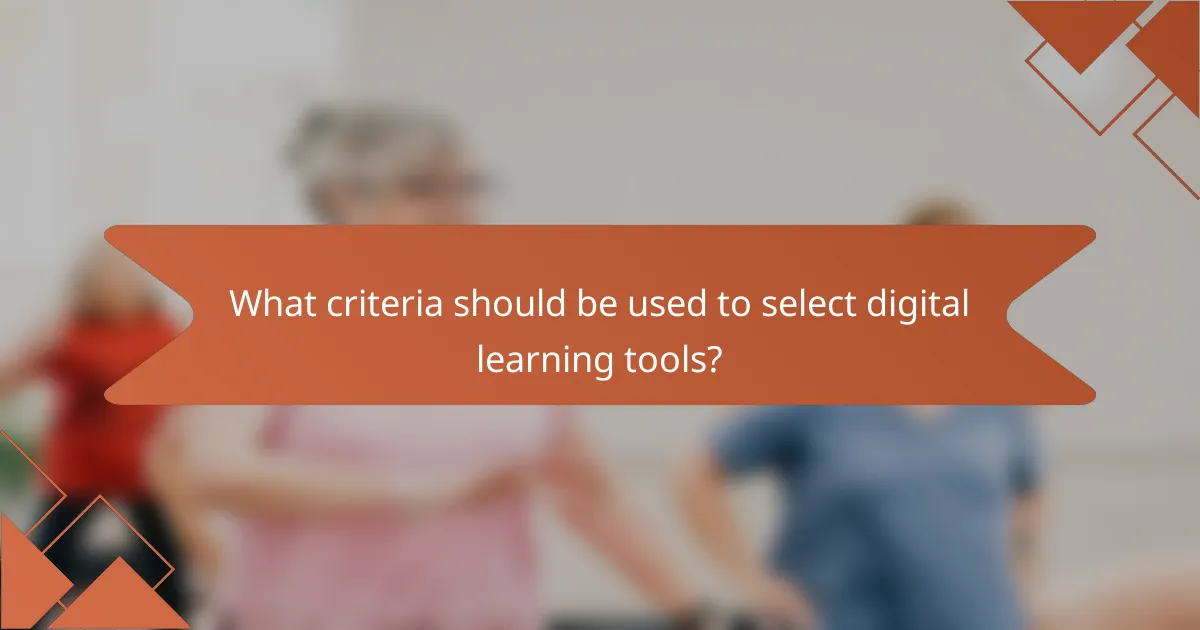Creating a productive learning environment with digital products involves leveraging technology to enhance collaboration, engagement, and organization. By utilizing the right tools and platforms, learners can interact more effectively and manage their projects efficiently, ultimately improving productivity and engagement in educational settings.

How to create a productive learning environment with digital products?
Creating a productive learning environment with digital products involves leveraging technology to enhance collaboration, engagement, and organization. By utilizing the right tools and platforms, learners can interact more effectively and manage their projects efficiently.
Utilizing online collaboration tools
Online collaboration tools facilitate real-time communication and teamwork among learners. Platforms like Slack, Microsoft Teams, and Google Workspace allow users to share documents, discuss ideas, and provide feedback instantly, fostering a sense of community.
To maximize effectiveness, choose tools that integrate well with each other and support the specific needs of your learning group. Regularly scheduled virtual meetings can help maintain momentum and ensure everyone is aligned on goals.
Incorporating interactive learning platforms
Interactive learning platforms, such as Kahoot! and Quizlet, engage students through gamified experiences and quizzes. These platforms encourage participation and make learning more enjoyable, which can lead to better retention of information.
When selecting an interactive platform, consider features like user-friendliness, accessibility, and the ability to track progress. Incorporating a mix of multimedia content can also cater to different learning styles, enhancing the overall experience.
Implementing digital project management software
Digital project management software, such as Trello or Asana, helps learners organize tasks, set deadlines, and monitor progress. These tools provide visual representations of workflows, making it easier to manage group projects and individual responsibilities.
To effectively implement project management software, establish clear guidelines for usage and ensure all participants are trained on the platform. Regular check-ins can help address any challenges and keep the project on track, ultimately leading to a more productive learning environment.

What are the best digital products for enhancing learning?
The best digital products for enhancing learning include tools that streamline organization, facilitate task management, and support virtual classrooms. These applications can significantly improve productivity and engagement in educational settings.
Notion for organization and note-taking
Notion is a versatile tool that combines note-taking, task management, and database capabilities, making it ideal for organizing learning materials. Users can create pages for different subjects, embed multimedia, and link related notes for easy navigation.
To maximize Notion’s potential, consider using templates for class notes or project planning. This can save time and ensure consistency across your materials. Be cautious, however, as the learning curve can be steep for new users.
Trello for task management
Trello is a visual task management tool that uses boards, lists, and cards to help users track their progress on various projects. It is particularly useful for managing assignments, deadlines, and group projects in an educational context.
To effectively use Trello, create separate boards for different subjects or projects and set due dates for tasks. Regularly updating your boards can prevent last-minute rushes and keep you on track. Avoid overcrowding boards with too many tasks, as this can lead to confusion.
Zoom for virtual classrooms
Zoom is a widely used platform for virtual classrooms, allowing educators to conduct live sessions with students regardless of location. Its features include screen sharing, breakout rooms, and recording options, which enhance the online learning experience.
When using Zoom, ensure you have a stable internet connection and familiarize yourself with the platform’s functionalities before class. Encourage student participation through polls and Q&A sessions to maintain engagement. Be mindful of time zones when scheduling classes to accommodate all participants.

How can digital products improve student engagement?
Digital products enhance student engagement by incorporating interactive elements that capture attention and foster participation. These tools create dynamic learning environments where students can actively participate, receive immediate feedback, and tailor their educational experiences.
Gamification techniques
Gamification techniques use game-like elements in educational settings to motivate students. By integrating points, badges, and leaderboards, learners are encouraged to complete tasks and engage with the material more deeply. For instance, a language learning app might reward users with points for daily practice, making the learning process more enjoyable.
When implementing gamification, consider balancing competition with collaboration to avoid discouraging less confident students. Aim for a mix of individual and group challenges to foster a supportive learning community.
Real-time feedback systems
Real-time feedback systems provide immediate responses to student actions, enhancing engagement and learning outcomes. Tools like quizzes and interactive assignments allow students to see their performance instantly, helping them identify areas for improvement. For example, an online math platform might offer instant corrections and hints, guiding students through problem-solving processes.
To maximize effectiveness, ensure that feedback is constructive and specific. Avoid vague comments and focus on actionable insights that students can apply to their future work.
Personalized learning experiences
Personalized learning experiences tailor educational content to individual student needs, preferences, and learning paces. Digital platforms can adapt lessons based on performance, allowing students to progress at their own speed. For instance, an adaptive learning system might present more challenging material to advanced learners while providing additional support to those who need it.
When designing personalized learning, gather data on student performance and preferences to inform content adjustments. Be cautious of over-reliance on technology; maintaining a human element in the learning process is crucial for fostering relationships and providing emotional support.

What criteria should be used to select digital learning tools?
Selecting digital learning tools requires careful consideration of user-friendliness, integration capabilities, and cost-effectiveness. These criteria help ensure that the tools enhance the learning experience and fit well within existing systems and budgets.
User-friendliness
User-friendliness is crucial for ensuring that both educators and learners can navigate the digital learning tools with ease. Look for intuitive interfaces that minimize the learning curve and allow users to focus on content rather than technology.
Consider tools that offer customizable features, enabling users to tailor the experience to their needs. A good rule of thumb is to choose platforms that provide comprehensive tutorials and customer support to assist users in overcoming initial challenges.
Integration capabilities
Integration capabilities determine how well a digital learning tool works with other systems and applications. Tools that seamlessly connect with Learning Management Systems (LMS), communication platforms, and assessment tools can streamline workflows and enhance collaboration.
When evaluating integration, check for compatibility with existing software and data formats. Tools that support APIs or have pre-built integrations can save time and reduce technical issues during implementation.
Cost-effectiveness
Cost-effectiveness involves assessing whether the benefits of a digital learning tool justify its price. Consider not only the initial purchase or subscription costs but also ongoing expenses such as maintenance, updates, and training.
Look for tools that offer tiered pricing models, allowing you to choose a plan that fits your budget while still meeting your needs. Free trials or freemium models can also provide an opportunity to evaluate the tool’s effectiveness before committing financially.

How to measure the effectiveness of digital learning environments?
Measuring the effectiveness of digital learning environments involves assessing various factors that contribute to student success. Key areas include student performance metrics, engagement analytics, and feedback surveys, each providing insights into how well the learning environment supports educational goals.
Student performance metrics
Student performance metrics are quantitative measures that reflect how well learners are achieving educational objectives. Common metrics include test scores, assignment completion rates, and overall grades. Tracking these metrics over time can help identify trends and areas needing improvement.
For example, if a significant number of students are consistently scoring below a certain threshold, it may indicate that the learning materials or methods need to be reevaluated. Regularly analyzing these metrics allows educators to make data-driven decisions to enhance the learning experience.
Engagement analytics
Engagement analytics measure how actively students participate in the digital learning environment. This can include metrics such as time spent on tasks, participation in discussions, and frequency of resource access. High engagement levels often correlate with better learning outcomes.
Tools like learning management systems (LMS) can provide detailed analytics, allowing educators to see which resources are most utilized and which activities generate the most interaction. Understanding these patterns can help in designing more engaging content and activities.
Feedback surveys
Feedback surveys are essential for gathering qualitative data on student experiences within digital learning environments. These surveys can assess satisfaction levels, perceived effectiveness of materials, and suggestions for improvement. Regularly soliciting feedback helps educators understand the strengths and weaknesses of their programs.
Surveys should be concise and focused, ideally administered at key points throughout the course. For instance, a mid-course survey can provide timely insights that allow for adjustments before the course concludes. Analyzing this feedback can lead to actionable changes that enhance the overall learning experience.

What are the emerging trends in digital learning environments?
Emerging trends in digital learning environments focus on enhancing user engagement and personalizing education. Key advancements include the integration of artificial intelligence and virtual reality, which create tailored and immersive learning experiences.
Artificial intelligence in personalized learning
Artificial intelligence (AI) is revolutionizing personalized learning by adapting educational content to meet individual student needs. AI algorithms analyze student performance and learning styles, allowing for customized lesson plans and resources that cater to each learner’s strengths and weaknesses.
For example, platforms like DreamBox and Knewton use AI to provide real-time feedback and adjust difficulty levels based on a student’s progress. This approach can significantly improve learning outcomes by ensuring that students remain engaged and challenged at an appropriate level.
When implementing AI in learning environments, educators should consider data privacy regulations and ensure that students’ information is protected. Additionally, it’s essential to provide training for both teachers and students to maximize the benefits of AI tools.
Virtual reality for immersive experiences
Virtual reality (VR) offers immersive learning experiences that enhance engagement and retention. By simulating real-world scenarios, VR allows students to explore complex concepts in a hands-on manner, making learning more interactive and effective.
For instance, medical students can practice surgical procedures in a safe, virtual environment, while history students can experience historical events firsthand. This type of experiential learning can lead to deeper understanding and greater enthusiasm for the subject matter.
To successfully integrate VR into educational settings, institutions should invest in quality hardware and software, as well as provide adequate training for instructors. It’s also important to consider the cost implications, as high-quality VR systems can be a significant investment, often ranging from hundreds to thousands of dollars per setup.
